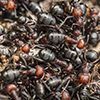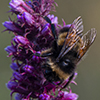Minnesota Ants, Bees, Wasps, and Sawflies
Hymenoptera (Ants, Bees, Wasps, and Sawflies) is the order of insects that is characterized by having two pairs of membranous wings and an ovipositor specialized for stinging or piercing. The order includes ants, bees, wasps, hornets, sawflies, and horntails.
There are about 125,000 known Hymenoptera species worldwide, about 18,000 species in more than 2,000 genera in North America north of Mexico. More than 1,000 species have been collected at Cedar Creek Ecosystem Science Reserve in Anoka County, Minnesota.

Recent Additions
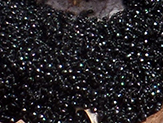
Taschenberg’s long-necked ant (Dolichoderus taschenbergi) is a small odorous ant. It occurs in the United States from Maine to North Dakota, south to Georgia and Louisiana, and in Canada from Nova Scotia to Manitoba. It is uncommon throughout its range but is most abundant in the north. It is found in open areas including old fields, woodland edges, and bogs. It forms huge colonies, often with multiple queens and more than 10,000 workers. It constructs igloo-shaped dome nests, 2″ to 8″ in height, using grasses, sphagnum mosses, spruce and pine needles, and other shredded vegetation. It the spring it can sometimes be found massed above ground warming in the sun.
Workers are uniformly colored. The overall color is sometimes interpreted as “dark brownish-black”, sometimes as “all black”, sometimes as “jet black”. The head and front part of the body are dull, the rear of the body is shiny. The last segment of the front part of the body (propodeum) is an important identifying feature. When viewed from above, the propodeum is squarish, about as long as wide. When viewed from the side, the propodeum is distinctly concave and has the appearance of a bottle opener.
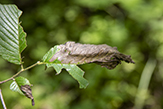
Elm leafminer (Fenusa ulmi) is a very small common sawfly. It is native to eastern Europe and Scandinavia. It was brought to North America most likely on imported elms. It now occurs in the United States from New England to the upper Midwest, in the Pacific Northwest, and in southeast Canada. Based on the scarcity of reports, it is still relatively uncommon in Minnesota. Adults are small and dark colored.
Due to the small size of the adult, elm leafminer is most often identified by the damage the larva causes to its host plant. Mines are seen from mid-May to early June on American elm and slippery elm. The larva feeds between the upper and lower surfaces of the leaf. It creates a serpentine mine at first. That soon develops into a small blotch between two lateral veins, later into a large blotch on one side if the midrib. The mines are clear and the flattened, whitish-green or yellowish-white larva can be seen when viewing the upper side of the leaf. The infected part of the leaf turns brown and eventually falls off. A heavy infestation may cause the entire tree to defoliate, but the infected tree flushes again and survives.
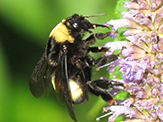
Black-and-gold bumble bee (Bombus auricomus) is common, large, colonial bumble bee. It occurs in North America east of the Rocky mountains. It is common in southern Minnesota, less common in the north. It is one of the largest bumble bees in Minnesota. Females (worker bees) are up to ¾″ long. It is found in grasslands and open areas. It lives in small colonies of about 35 workers.
Black-and-gold bumble bee is identified by its large size; there is a patch of yellow hairs on the back of the head; the thorax that is yellow on the front third, black on the rear two thirds, and has a very narrow yellow band at the rear; and the abdomen is black except for the entirely yellow second and third segments.
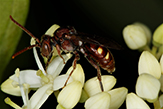
There are more than 850 species of nomad bee (Nomada sp.) worldwide, more than 280 species in North America. Like other cuckoo bees (subfamily Nomadinae), nomad bees do not construct nests, but lay their eggs in the nests of ground-nesting bees. One to four eggs are laid in the cell wall of the host nest. The larvae have large, outward-facing, scissor-like mandibles. The first larva to emerge destroys all the other eggs, both those of the host and those of its own siblings. It consumes the pollen provisioned by its host, and emerges as an adult the same time as the host adults emerge.
Nomad bees are usually black, black and red, or entirely red, with yellow, white, and/or red markings. Many species have red legs. The genus Nomada includes the only bees in North America that are entirely red. They have short, thin, and inconspicuous hairs on the body and no pollen-collecting hairs (scopa) on the hind legs. They look more like wasps than a bees.
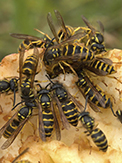
Downy yellowjacket (Vespula flavopilosa) is an uncommon, medium-sized, predatory, social wasp. It is found in the northeastern United States from Minnesota to Maine, south to Virginia, and along the Appalachian mountains to northern Georgia. It closely resembles eastern yellowjacket. It is thought by some to be a hybrid between eastern and common yellowjackets. Others suggest that it probably arose as a hybrid but now queens mate with drones of the same species.
The overwintering queen emerges from hibernation in April or May. She builds a nest of 20 to 45 cells and cares for the grubs as they hatch. In about 30 days the workers emerge and take over nest building duties. Through spring and summer the queen produces a large number of worker wasps. In mid-summer, the nest grows exponentially, as more and more workers become available, ultimately with 3,500 to 15,000 cells. Only the new queens survive the winter, hibernating under loose tree bark, in a decaying stump, or in another sheltered location.
In eastern North America, four yellowjacket species, common, downy, eastern, and German yellowjackets, closely resemble each other, making identification difficult. Downy yellowjacket is distinguished from the others by a continuous, uninterrupted yellow band on the face below the compound eye; and by the shape and pattern of black markings on the first and second abdominal segments.
Other Recent Additions
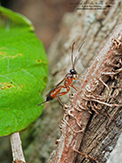
eastern thistle longhorn bee (Melissodes desponsus)
ichneumonid wasps (Subtribe Agrothereutina)
pruinose squash bee (Peponapis pruinosa)
five-banded thynnid wasp (Myzinum quinquecinctum)
agile longhorn bee (Melissodes agilis)
dark-footed yellow loosestrife bee (Macropis nuda)
This list includes only ants, bees, wasps, and sawflies that have been recorded in Minnesota, but not all of the ants, bees, wasps, and sawflies found in Minnesota.
| A | |||||
|---|---|---|---|---|---|
| Profile | Photo | Video | |||
Abanc’s sweat bee (Lasioglossum abanci) |
|||||
|
aberrant cellophane bee (Colletes aberrans) |
||||
admirable sweat bee (Lasioglossum admirandum) |
|||||
Allegheny mining bee (Andrena alleghaniensis) |
|||||
alternate cuckoo-leaf-cutter bee (Coelioxys alternatus) |
|||||
amber-winged sweat bee (Lasioglossum succinipenne) |
|||||
American ant (Myrmica americana) |
|||||
American bumble bee (Bombus pensylvanicus) |
|||||
American cellophane bee (Colletes americanus) |
|||||
Andrew’s cellophane bee (Colletes andrewsi) |
|||||
annulate masked bee (Hylaeus annulatus) |
|||||
anomalous sweat bee (Lasioglossum anomalum) |
|||||
argid sawflies (Family Argidae) |
|||||
argid sawfly (Arge clavicornis) |
|||||
argid sawfly (Arge coccinea) |
|||||
articulated nomad bee (Nomada articulata) |
|||||
aster cellophane bee (Colletes compactus) |
|||||
aster mining bee (Andrena asteris) |
|||||
Atlantic cuckoo sweat bee (Sphecodes atlantis) |
|||||
augochlorine sweat bee (Augochloropsis sumptuosa) |
|||||
augochlorine sweat bees (Tribe Augochlorini) |
| B | |||||
|---|---|---|---|---|---|
| Profile | Photo | Video | |||
|
|
|||||
bald-spot sweat bee (Lasioglossum paraforbesii) |
|||||
band-footed sweat bee (Lasioglossum cinctipes) |
|||||
Bank’s nomad bee (Nomada banksi) |
|||||
bare dogwood miner (Andrena integra) |
|||||
beach dune cellophane bee (Colletes speculiferus) |
|||||
beebalm shortface (Dufourea monardae) |
|||||
bellflower resin bee (Megachile campanulae) |
|||||
beloved vespid wasp (Odynerus dilectus) |
|||||
bilobed cuckoo sweat bee (Sphecodes confertus) |
|||||
birch sawfly (Arge pectoralis) |
|||||
black and red horntail (Urocerus cressoni) |
|||||
black-and-gray leaf-cutter bee (Megachile melanophaea) |
|||||
black-and-green metallic sweat bee (Lasioglossum nigroviride) |
|||||
black-and-white mason wasp (Euodynerus leucomelas) |
|||||
black-and-yellow nomad (Nomada luteoloides) |
|||||
black-headed ash sawfly (Tethida barda) |
|||||
black-tailed long-horned bee (Eucera atriventris) |
|||||
black-tipped cuckoo sweat bee (Sphecodes prosphorus) |
|||||
blood bee (Sphecodes antennariae) |
|||||
blood bee (Sphecodes banksii) |
|||||
blood bee (Sphecodes carolinus) |
|||||
blood bee (Sphecodes fattigi) |
|||||
blood-red ant (Formica sanguinea) |
|||||
blue orchard bee (Osmia lignaria lignaria) |
|||||
blueberry cellophane bee (Colletes validus) |
|||||
blue-winged scolid wasp (Scolia dubia) |
|||||
braconid wasp (Atanycolus charus) |
|||||
braconid wasp (Atanycolus crassicruris) |
|||||
braconid wasp (Atanycolus longicauda) |
|||||
braconid wasp (Atanycolus nigropyga) |
|||||
braconid wasp (Atanycolus niteofrons) |
|||||
braconid wasp (Atanycolus rugosiventris) |
|||||
braconid wasp (Atanycolus simplex) |
|||||
braconid wasp (Atanycolus ulmicola) |
|||||
braconid wasps (Opius spp.) |
|||||
braconid wasps (Spathius spp.) |
|||||
Bradley’s mining bee (Andrena bradleyi) |
|||||
bramble mason wasp (Ancistrocerus adiabatus) |
|||||
bristle sweat bee (Lasioglossum imitatum) |
|||||
broad-footed cellophane bee (Colletes latitarsis) |
|||||
brown-headed ash sawfly (Tomostethus multicinctus) |
|||||
brown-winged striped sweat bee (Agapostemon splendens) |
|||||
Bruner’s sweat bee (Lasioglossum bruneri) |
|||||
| C | |||||
|---|---|---|---|---|---|
| Profile | Photo | Video | |||
|
|
|||||
Canadian mining bee (Andrena canadensis) |
|||||
capped cuckoo sweat bee (Sphecodes galerus) |
|||||
Carlin’s mining bee (Andrena carlini) |
|||||
carrot wasps (Gasteruption spp.) |
|||||
cellophane bee (Colletes eulophi) |
|||||
chalcidid wasp (Conura delumbis) |
|||||
chalcidid wasp (Conura melana) |
|||||
chalcidid wasps (Conura side complex) |
|||||
chalcidoid wasp (Leucospis affinis) |
|||||
chalcidoid wasp (Monodontomerus mexicanus) |
|||||
chalcidoid wasp (Monodontomerus minor) |
|||||
chalcidoid wasps (Kocourekia spp.) |
|||||
chalcidoid wasps (Leucospis spp.) |
|||||
chalcidoid wasps (Melittobia spp.) |
|||||
chalcidoid wasps (Oodera spp.) |
|||||
chalcidoid wasps (Tetrastichus spp.) |
|||||
cinquefoil yellow-faced bee (Hylaeus basalis) |
|||||
clematis blood bee (Sphecodes clematidis) |
|||||
club-horned cuckoo wasp (Sapyga martini) |
|||||
columbine sawfly (Pristiphora rufipes) |
|||||
commodius miner bee (Andrena commoda) |
|||||
common ectemnius (Ectemnius continuus) |
|||||
common little leaf-cutter bee (Megachile brevis) |
|||||
common sawflies (Monophadnoides spp.) |
|||||
common sawflies (Subfamily Nematinae) |
|||||
common sawfly (Macrophya alboa) |
|||||
common sawfly (Macrophya cassandra) |
|||||
common sawfly (Macrophya cinctula) |
|||||
common sawfly (Macrophya festana) |
|||||
common sawfly (Macrophya flavicoxae) |
|||||
common sawfly (Macrophya flavolineata) |
|||||
common sawfly (Macrophya fulginea) |
|||||
common sawfly (Macrophya intermedia) |
|||||
common sawfly (Macrophya lineatana) |
|||||
common sawfly (Macrophya macgillivrayi) |
|||||
common sawfly (Macrophya maculilabris) |
|||||
common sawfly (Macrophya mensa) |
|||||
common sawfly (Macrophya pannosa) |
|||||
common sawfly (Macrophya senacca) |
|||||
common sawfly (Macrophya simillima) |
|||||
common sawfly (Macrophya succincta) |
|||||
common sawfly (Macrophya tibiator) |
|||||
common sawfly (Macrophya zoe) |
|||||
common star-of-Bethlehem (Ornithogalum umbellatum) |
|||||
common thread-waisted wasp (Ammophila procera) |
|||||
common yellowjacket (Vespula alascensis) |
|||||
coneflower mining bee (Andrena rudbeckiae) |
|||||
confusing long-horned bee (Melissodes confusa) |
|||||
constrained cuckoo carder bee (Stelis coarctatus) |
|||||
crabronid wasps (Tachytes spp.) |
|||||
cranesbill miner (Andrena distans) |
|||||
Cresson’s cuckoo sweat bee (Sphecodes cressonii) |
|||||
Cresson’s mining bee (Andrena cressonii) |
|||||
Cresson’s nomad bee (Nomada cressonii) |
|||||
Cresson’s sweat bee (Lasioglossum cressonii) |
|||||
cross potter wasp (Eumenes crucifera-nearcticus) |
|||||
crowned cuckoo sweat bee (Sphecodes coronus) |
|||||
cryptic mason wasp (Euodynerus crypticus) |
|||||
cuckoo wasp (Chrysura smaragdula) |
|||||
cuckoo wasp (Hedychrum confusum) |
|||||
cuckoo wasp (Muesbeckidium obsoletum) |
|||||
cuckoo wasp (Trichrysis doriae) |
|||||
cuckoo wasps (Family Chrysididae) |
|||||
cuneate nomad bee (Nomada cuneata) |
|||||
cyclops blood bee (Sphecodes heraclei) |
| D | |||||
|---|---|---|---|---|---|
| Profile | Photo | Video | |||
deadly cuckoo sweat bee (Sphecodes stygius) |
|||||
decorated sweat bee (Lasioglossum pictum) |
|||||
deep blue sweat bee (Lasioglossum coeruleum) |
|||||
densely punctured sweat bee (Lasioglossum perpunctatum) |
|||||
denticulate cuckoo nomad bee (Nomada denticulata) |
|||||
denticulate long-horned bee (Melissodes denticulatus) |
|||||
depressed cuckoo nomad bee (Nomada depressa) |
|||||
dilated-horned small-mason (Hoplitis spoliata) |
|||||
Dreisbach’s sweat bee (Lasioglossum dreisbachi) |
|||||
Drury’s long-horned bee (Melissodes druriellus) |
|||||
dull-breasted sweat bee (Lasioglossum pectorale) |
|||||
Dunning’s mining bee (Andrena dunningi) |
|||||
dusky birch sawfly (Croesus latitarsus) |
|||||
dwarf-dandelion mining bee (Andrena krigiana) |
| E | |||||
|---|---|---|---|---|---|
| Profile | Photo | Video | |||
early sawfly (Dolerus unicolor) |
|||||
eastern cuckoo sweat bee (Sphecodes pimpinellae) |
|||||
eastern green sweat bee (Lasioglossum viridatum) |
|||||
eastern miner bee (Calliopsis andreniformis) |
|||||
eastern yellow-faced bee (Hylaeus affinis) |
|||||
eight-toothed cuckoo leaf-cutter bee (Coelioxys octodentatus) |
|||||
elder strider (Macrophya alboannulata) |
|||||
elm argid sawfly (Arge scapularis) |
|||||
eucera cuckoo nomad bee (Triepeolus cressonii) |
|||||
European tube wasp (Ancistrocerus gazella) |
|||||
experienced sweat bee (Lasioglossum versatum) |
|||||
|
|||||
|
|||||
|
|||||
|
|||||
|
|||||
|
|||||
|
|||||
|
|||||
|
|||||
|
|||||
|
|||||
|
|||||
|
| F | |||||
|---|---|---|---|---|---|
| Profile | Photo | Video | |||
Fernald's cuckoo bumble bee (Bombus fernaldae) |
|||||
five-spined nomad (Nomada australis) |
|||||
flat-tailed leaf-cutter bee (Megachile mendica) |
|||||
Florida masked bee (Hylaeus floridanus) |
|||||
Forbes’s sweat bee (Lasioglossum forbesii) |
|||||
forest yellowjacket (Vespula acadica) |
|||||
four-banded stink bug hunter wasp (Bicyrtes quadrifasciatus) |
|||||
four-toothed mason wasp (Monobia quadridens) |
|||||
friendless sweat bee (Lasioglossum versans) |
|||||
frigid bumble bee (Bombus frigidus) |
|||||
frigid leaf-cutter bee (Megachile frigida) |
|||||
fuzzy mound ant (Formica lasioides) |
|||||
|
|||||
|
|||||
|
| G | |||||
|---|---|---|---|---|---|
| Profile | Photo | Video | |||
goatsbeard miner bee (Andrena spiraeana) |
|||||
golden-alexanders mining bee (Andrena ziziae) |
|||||
goldenrod cellophane bee (Colletes solidaginis) |
|||||
goldenrod longhorn-cuckoo bee (Triepeolus pectoralis) |
|||||
goldenrod long-horned bee (Melissodes menuachus) |
|||||
golden-tailed leafcutter bee (Megachile relativa) |
|||||
gold-marked thread-waisted wasp (Eremnophila aureonotata) |
|||||
gouty oak gall wasp (Callirhytis quercus punctata) |
|||||
Graenicher’s cuckoo nomad bee (Nomada graenicheri) |
|||||
ground hornet (Vespula vidua) |
|||||
|
|||||
|
|||||
|
|||||
|
|||||
|
|||||
|
|||||
|
| H | |||||
|---|---|---|---|---|---|
| Profile | Photo | Video | |||
hairy poplar sawfly (Cladius grandis) |
|||||
hairy sweat bee (Lasioglossum pilosum) |
|||||
half-belted blue-black spider wasp (Anoplius semicinctus) |
|||||
half-blue sweat bee (Lasioglossum semicaeruleum) |
|||||
hawthorn leafminer (Profenusa canadensis) |
|||||
hawthorn mining bee (Andrena crataegi) |
|||||
hibiscus sawfly (Atomacera decepta) |
|||||
Hidalgo mason wasp (Euodynerus hidalgo) |
|||||
high noon ant (Forelius pruinosus) |
|||||
hoary sweat bee (Lasioglossum pruinosum) |
|||||
horseshoe sweat bee (Lasioglossum illinoense) |
|||||
Hunt’s bumble bee (Bombus huntii) |
|||||
hyaline cellophane bee (Colletes hyalinus) |
| I | |||||
|---|---|---|---|---|---|
| Profile | Photo | Video | |||
|
|
|||||
ichneumonid wasp (Arcotomus succinctus) |
|||||
ichneumonid wasp (Cosmoconus canadensis) |
|||||
ichneumonid wasp (Cratichneumon annulatipes) |
|||||
ichneumonid wasp (Cratichneumon paratus) |
|||||
ichneumonid wasp (Cratichneumon pteridis) |
|||||
ichneumonid wasp (Cratichneumon sublatus) |
|||||
ichneumonid wasp (Cratichneumon tyloidifer) |
|||||
ichneumonid wasp (Cratichneumon unifasciatorius) |
|||||
ichneumonid wasp (Cratichneumon vescus) |
|||||
ichneumonid wasp (Cratichneumon vinnulus) |
|||||
ichneumonid wasp (Cratichneumon w-album) |
|||||
ichneumonid wasp (Ephialtes macer) |
|||||
ichneumonid wasp (Exochus dorsalis) |
|||||
ichneumonid wasp (Gelis meabilis) |
|||||
ichneumonid wasp (Lissonota acrobasidis) |
|||||
ichneumonid wasp (Lissonota atrimalis) |
|||||
ichneumonid wasp (Lissonota brevipappus) |
|||||
ichneumonid wasp (Lissonota brunnea) |
|||||
ichneumonid wasp (Lissonota conferta) |
|||||
ichneumonid wasp (Lissonota coracina) |
|||||
ichneumonid wasp (Lissonota crevieri) |
|||||
ichneumonid wasp (Lissonota cruralis) |
|||||
ichneumonid wasp (Lissonota cylpeator) |
|||||
ichneumonid wasp (Lissonota exigua) |
|||||
ichneumonid wasp (Lissonota exilis) |
|||||
ichneumonid wasp (Lissonota imitatrix) |
|||||
ichneumonid wasp (Lissonota parva) |
|||||
ichneumonid wasp (Lissonota punctata) |
|||||
ichneumonid wasp (Lissonota rubrica) |
|||||
ichneumonid wasp (Lissonota scutellaris) |
|||||
ichneumonid wasp (Lissonota stenostoma) |
|||||
ichneumonid wasp (Lissonota tegularis) |
|||||
ichneumonid wasp (Ophionellus texanus) |
|||||
ichneumonid wasp (Poemenia albipes) |
|||||
ichneumonid wasp (Poemenia americana) |
|||||
ichneumonid wasp (Polytribax pallescens) |
|||||
ichneumonid wasp (Setanta compta) |
|||||
ichneumonid wasp (Therion fuscipenne) |
|||||
ichneumonid wasp (Therion morio) |
|||||
ichneumonid wasp (Therion nigripes) |
|||||
ichneumonid wasp (Therion petiolatum) |
|||||
ichneumonid wasp (Therion tenuipes) |
|||||
ichneumonid wasp (Therion texanum) |
|||||
ichneumonid wasps (Diadegma spp.) |
|||||
ichneumonid wasps (Euceros spp.) |
|||||
ichneumonid wasps (Glypta spp.) |
|||||
ichneumonid wasps (Sinophorus spp.) |
|||||
ichneumonid wasps (Subfamily Campopleginae) |
|||||
Illinois cuckoo nomad bee (Nomada illinoensis) |
|||||
Illinois cuckoo sweat bee (Sphecodes illinoensis) |
|||||
imbricate cuckoo nomad bee (Nomada imbricata) |
|||||
impunctate cellophane bee (Colletes impunctatus) |
|||||
indiscriminate cuckoo bumble bee (Bombus insularis) |
|||||
introduced pine sawfly (Diprion similis) |
| J | |||||
|---|---|---|---|---|---|
| Profile | Photo | Video | |||
Johnson’s cuckoo sweat bee (Sphecodes johnsonii) |
| K | |||||
|---|---|---|---|---|---|
| Profile | Photo | Video | |||
Kincaid’s cellophane bee (Colletes kincaidii) |
|||||
|
kindred cellophane bee (Colletes consors) |
| L | |||||
|---|---|---|---|---|---|
| Profile | Photo | Video | |||
larch sawfly (Pristiphora erichsonii) |
|||||
large ectemnius (Ectemnius cephalotes) |
|||||
leaf-cutter bee (Megachile dakotensis) |
|||||
leaf-cutter bee (Megachile nivalis) |
|||||
leathery sweat bee (Lasioglossum coriaceum) |
|||||
light bronze mound ant (Formica subaenescens) |
|||||
lineolated sweat bee (Lasioglossum lineatulum) |
|||||
little black ant (Monomorium minimum) |
|||||
longhorn bee (Melissodes boltoniae) |
|||||
longhorn bee (Melissodes wheeleri) |
|||||
long-horned bee (Melissodes grindelliae) |
|||||
long-lipped miner (Andrena barbilabris) |
|||||
long-tailed giant ichneumonid wasp (Megarhyssa macrurus) |
|||||
Los Angeles leafcutter bee (Megachile angelarum) |
|||||
lunate longhorn-cuckoo (Triepeolus lunatus) |
|||||
|
|||||
|
|||||
|
|||||
|
|||||
|
|||||
|
| M | |||||
|---|---|---|---|---|---|
| Profile | Photo | Video | |||
Macoupin County sweat bee (Lasioglossum macoupinense) |
|||||
mandibular cellophane bee (Colletes mandibularis) |
|||||
maple petiole borer (Caulocampus acericaulis) |
|||||
Maria miner bee (Andrena mariae) |
|||||
mason bee (Osmia subarctica) |
|||||
Mesilla yellow-faced bee (Hylaeus mesillae) |
|||||
metallic epauletted-sweat bee (Augochloropsis metallica) |
|||||
metallic sweat bee (Lasioglossum apertum) |
|||||
metallic sweat bee (Lasioglossum basilicum) |
|||||
metallic sweat bee (Lasioglossum junaluskense) |
|||||
metallic sweat bee (Lasioglossum nymphale) |
|||||
metallic sweat bee (Lasioglossum orbitatum) |
|||||
metallic sweat bee (Lasioglossum platyparium) |
|||||
metallic sweat bee (Lasioglossum rohweri) |
|||||
metallic sweat bee (Lasioglossum rozeni) |
|||||
metallic sweat bee (Lasioglossum sandhouseae) |
|||||
metallic sweat bee (Lasioglossum unicum) |
|||||
mining bee (Protandrena bancrofti) |
|||||
mining bee (Pseudopanurgus albitarsis) |
|||||
mining bees (Andrena Subgenus Melandrena) |
|||||
minor cuckoo sweat bee (Sphecodes minor) |
|||||
miserable mining bee (Andrena miserabilis) |
|||||
mossy rose gall wasp (Diplolepis rosae) |
|||||
mountain ash sawfly (Pristiphora geniculata) |
| N | |||||
|---|---|---|---|---|---|
| Profile | Photo | Video | |||
Nason’s mining bee (Andrena nasonii) |
|||||
neighborly mining bee (Andrena vicina) |
|||||
neighborly nomad (Nomada vicina) |
|||||
nelumbo masked bee (Hylaeus nelumbonis) |
|||||
Nevada bumble bee (Bombus nevadensis) |
|||||
New World mound ant (Formica neogagates) |
|||||
nimble cuckoo sweat bee (Sphecodes levis) |
|||||
nimble long-horned bee (Melissodes subagilis) |
|||||
northern red wood ant (Formica obscuriventris) |
|||||
notch-backed cellophane-cuckoo bee (Epeolus scutellaris) |
|||||
|
|||||
|
|||||
|
| O | |||||
|---|---|---|---|---|---|
| Profile | Photo | Video | |||
oak gall wasp (Neuroterus exiguissimus) |
|||||
oak gall wasps (Tribe Cynipini) |
|||||
obliterated nomad (Nomada obliterata) |
|||||
oblong sweat bee (Lasioglossum oblongum) |
|||||
oblong wool carder bee (Anthidium oblongatum) |
|||||
obscure sweat bee (Lasioglossum obscurum) |
|||||
Ocean Grove sweat bee (Lasioglossum nymphaearum) |
|||||
one-banded mason wasp (Ancistrocerus unifasciatus) |
|||||
orange-bellied mummy wasp (Aleiodes abdominalis) |
|||||
ovate cuckoo nomad bee (Nomada ovata) |
|||||
|
|||||
|
|||||
|
|||||
|
|||||
|
|||||
|
|||||
|
|||||
|
| P | |||||
|---|---|---|---|---|---|
| Profile | Photo | Video | |||
pale field ant (Formica pallidefulva) |
|
||||
pale-marked long-horned bee (Melissodes pallidisignatus) |
|||||
parallel-striped sweat bee (Halictus parallelus) |
|||||
parsnip miner bee (Andrena thaspii) |
|||||
patchwork leafcutter bee (Megachile centuncularis) |
|||||
peaceful mining bee (Andrena placata) |
|||||
pear sawfly (Caliroa cerasi) |
|||||
perennial mason wasp (Parancistrocerus perennis) |
|||||
petulant leaf-cutter bee (Megachile petulans) |
|||||
pitted mound ant (Formica fossaceps) |
|||||
plated miner bee (Andrena platyparia) |
|||||
potter and mason wasps (Leptochilus spp.) |
|||||
potter or mason wasp (Eumenes bollii) |
|||||
potter or mason wasp (Euodynerus boscii) |
|||||
potter or mason wasp (Leptochilus ornatus) |
|||||
potter or mason wasp (Parancistrocerus fulvipes) |
|||||
potter or mason wasp (Parancistrocerus leionotus) |
|||||
potter or mason wasp (Pterocheilus quinquefasciatus) |
|||||
potter or mason wasp (Stenodynerus ammonia) |
|||||
potter or mason wasp (Stenodynerus anormis) |
|||||
pugnacious leaf-cutter bee (Megachile pugnata) |
|||||
pygmy nomad bee (Nomada pygmaea) |
|||||
|
|||||
|
|||||
|
| Q | |||||
|---|---|---|---|---|---|
| Profile | Photo | Video | |||
|
|||||
|
| R | |||||
|---|---|---|---|---|---|
| Profile | Photo | Video | |||
redheaded pine sawfly (Neodiprion lecontei) |
|
||||
red-bearded mound ant (Formica neorufibarbis) |
|||||
red-belted plasterer bee cellophane bee (Colletes rufocinctus) |
|||||
red-tailed mining bee (Andrena erythrogaster) |
|||||
red-toothed cuckoo sweat bee (Sphecodes mandibularis) |
|||||
resin bee (Heriades carinata) |
|||||
ringed mason wasp (Euodynerus annulatus) |
|||||
Robertson’s plasterer bee (Colletes robertsonii) |
|||||
robust sunflower leafcutter bee (Megachile fortis) |
|||||
round bullet gall wasp (Disholcaspis quercusglobulus) |
|||||
rudbeckia yellow-faced bee (Hylaeus rudbeckiae) |
|||||
ruddy nomad bee (Nomada rubicunda) |
|||||
ruddy slave-making mound ant (Formica rubicunda) |
|||||
rugose mining bee (Andrena rugosa) |
|||||
rugose-fronted resin bee (Megachile rugifrons) |
|||||
| S | |||||
|---|---|---|---|---|---|
| Profile | Photo | Video | |||
|
|
|||||
Sanderson’s bumble bee (Bombus sandersoni) |
|||||
sanicle yellow-faced bee (Hylaeus saniculae) |
|||||
sawflies, horntails, and wood wasps (Suborder Symphyta) |
|||||
Say’s cuckoo nomad bee (Nomada sayi) |
|||||
Say’s sunflower burrowing-resin bee (Paranthidium jugatorium jugatorium) |
|||||
scalloped cuckoo sweat bee (Sphecodes dichrous) |
|||||
scorpionweed plasterer bee (Colletes phaceliae) |
|||||
sculptured resin bee (Megachile sculpturalis) |
|||||
shining griever (Dolerus nitens) |
|||||
shiny-faced cuckoo sweat bee (Sphecodes solonis) |
|||||
short leafcutter bee (Megachile brevis) |
|||||
short-horned cellophane bee (Colletes brevicornis) |
|||||
short-spined ant (Myrmica brevispinosa) |
|||||
short-tongued miner bee (Andrena brevipalpis) |
|||||
short-winged Darwin wasp (Agrothereutes abbreviatus) |
|||||
Sigmund’s mining bee (Andrena sigmundi) |
|||||
silver-tailed petalcutter (Megachile montivaga) |
|||||
silvery field ant (Formica argentea) |
|||||
similar mason bee (Osmia simillima) |
|||||
simple miner bee (Andrena simplex) |
|||||
sixteen-spotted cuckoo carder bee (Stelis permaculata) |
|||||
slender-faced yellow-faced bee (Hylaeus leptocephalus) |
|||||
smaller yellow ant (Lasius claviger) |
|||||
small-handed leaf-cutter bee (Megachile gemula) |
|||||
smoky-winged beetle bandit wasp (Cerceris fumipennis) |
|||||
spider wasp (Auplopus archictectus) |
|||||
spider wasp (Auplopus caerulescens) |
|||||
spider wasp (Auplopus nigrellus) |
|||||
spine-shouldered cellophane bee (Colletes simulans) |
|||||
Spinola’s mason wasp (Ancistrocerus spinolae) |
|||||
spotted cuckoo spider wasp (Ceropales maculata) |
|||||
spotted nomad bee (Nomada maculata) |
|||||
spring beauty miner (Andrena erigeniae) |
|||||
square-headed wasp (Ectemnius dives) |
|||||
square-headed wasps, sand wasps, and allies (Astata spp.) |
|||||
squash longhorn-cuckoo (Triepeolus remigatus) |
|||||
striped sweat bees (Agapostemon spp.) |
|||||
stunning sweat bee (Lasioglossum paradmirandum) |
|||||
sumac cellophane bee (Colletes nudud) |
|||||
sunflower mining bee (Andrena helianthi) |
|||||
superb nomada (Nomada superba) |
|||||
Susanna’s cellophane bee (Colletes susannae) |
|||||
| T | |||||
|---|---|---|---|---|---|
| Profile | Photo | Video | |||
Texas striped sweat bee (Agapostemon texanus) |
|||||
thief ant (Solenopsis molesta) |
|||||
thimbleberry stem gall wasp (Diastrophus kincaidii) |
|||||
thread-waisted wasp (Ammophila nigricans) |
|||||
thynnid flower wasp (Myzinum carolinianum) |
|||||
thynnid flower wasp (Myzinum maculatum) |
|||||
tickseed long-horned bee (Melissodes coreopsis) |
|||||
tiny crazy ant (Nylanderia parvula) |
|||||
tiny-queened field ant (Lasius minutus) |
|||||
toothed miner bee (Andrena mandibularis) |
|||||
tooth-bellied long-horned bee (Melissodes dentiventris) |
|||||
translucent oak gall wasp (Amphibolips nubilipennis) |
|||||
tufted potter wasp (Symmorphus cristatus) |
|||||
twig mason bee (Osmia virga) |
|||||
two-spotted longhorn bee (Melissodes bimaculatus ssp. bimaculatus) |
|||||
two-toothed long-horned bee (Melissodes bidentis) |
|||||
|
|||||
|
|||||
|
|||||
|
|||||
|
|||||
|
|||||
|
| U | |||||
|---|---|---|---|---|---|
| Profile | Photo | Video | |||
Ulke’s ant (Formica ulkei) |
|
||||
unarmed leafcutter bee (Megachile inermis) |
|||||
uncertain field ant (Formica incerta) |
|||||
unequal cellophane bee (Colletes inaequalis) |
| V | |||||
|---|---|---|---|---|---|
| Profile | Photo | Video | |||
valiant long-horned bee (Melissodes illatus) |
|||||
velvet ants (Dasymutilla spp.) |
|||||
vertical potter wasp (Eumenes verticalis) |
|||||
vertical yellow-faced bee (Hylaeus verticalis) |
|||||
very smooth sweat bee (Lasioglossum laevissimum) |
|||||
Viereck’s sweat bee (Lasioglossum vierecki) |
|||||
vigorous long-horned bee (Melissodes subillatus) |
| W | |||||
|---|---|---|---|---|---|
| Profile | Photo | Video | |||
Walden’s potter wasp (Ancistrocerus waldenii) |
|
||||
walking mason wasp (Parancistrocerus pedestris) |
|||||
wall mason wasp (Ancistrocerus parietum) |
|||||
wandering mason wasp (Parancistrocerus vagus) |
|||||
waterleaf mining bee (Andrena geranii) |
|||||
water-lily sweat bee (Lasioglossum nelumbonis) |
|||||
weevil wasp (Cerceris halone) |
|||||
Wellesley miner bee (Andrena wellesleyana) |
|||||
western green sweat bee (Lasioglossum subviridatum) |
|||||
western leafcutter (Megachile perihirta) |
|||||
western thistle long-horned bee (Melissodes rivalis) |
|||||
white cellophane bee (Colletes albescens) |
|||||
white pine sawfly (Neodiprion pinetum) |
|||||
white-banded potter wasp (Ancistrocerus albophaleratus) |
|||||
white-bellied mason bee (Osmia albiventris) |
|||||
white-haired golden sweat bee (Lasioglossum leucocomus) |
|||||
white-horned horntail (Urocerus albicornis) |
|||||
white-winged sweat bee (Lasioglossum albipenne) |
|||||
white-zoned furrow bee (Lasioglossum leucozonium) |
|||||
wide-faced ant (Myrmica latifrons) |
|||||
wide-footed field ant (Lasius latipes) |
|||||
wide-mouthed sweat bee (Lasioglossum heterognathus) |
|||||
wide-shouldered sweat bee (Lasioglossum tegulare species group) |
|||||
Wilke’s mining bee (Andrena wilkella) |
|||||
Williston’s cellophane bee (Colletes willistoni) |
|||||
willow leaf galls (Pontania spp.) |
|||||
willow oak sawfly (Arge quidia) |
|||||
willow sawfly (Nematus ventralis) |
|||||
Wilmatte’s plasterer bee (Colletes wilmattae) |
|||||
wily field ant (Formica dolosa) |
|||||
winter ant (Prenolepis imparis) |
|||||
wool-bearing gall wasp (Andricus quercuslanigera) |
| X | |||||
|---|---|---|---|---|---|
| Profile | Photo | Video | |||
|
|||||
|
| Y | |||||
|---|---|---|---|---|---|
| Profile | Photo | Video | |||
yellow shadow ant (Lasius aphidicola) |
|||||
yellow-faced bee (Hylaeus fedorica) |
|||||
yellowjackets (Vespula spp.) |
|||||
|
|||||
|
|||||
|
| Z | |||||
|---|---|---|---|---|---|
| Profile | Photo | Video | |||
zephyr sweat bee (Lasioglossum zephyrus) |
|||||
|
Acroricnus stylator aequatus (ichneumonid wasp)
Agapostemon sericeus (silky striped sweat bee)
Agapostemon splendens (brown-winged striped sweat bee)
Agapostemon spp. (striped sweat bees)
Agapostemon texanus (Texas striped sweat bee)
Agapostemon virescens (bicolored striped sweat bee)
Agrothereutes abbreviatus (short-winged Darwin wasp)
Agrothereutina (ichneumonid wasps)
Aleiodes abdominalis (orange-bellied mummy wasp)
Aleiodes pseudoterminalis (false terminal mummy wasp)
Aleiodes terminalis (terminal mummy wasp)
Allantus cinctus (curled rose sawfly)
Alysson oppositus (crabronid wasp)
Ammophila nigricans (thread-waisted wasp)
Ammophila pictipennis (thread-waisted wasp)
Ammophila procera (common thread-waisted wasp)
Amphibolips confluenta (spongy oak apple gall wasp)
Amphibolips cookii (oak apple gall wasp)
Amphibolips nubilipennis (translucent oak gall wasp)
Amphibolips quercusinanis (larger empty oak apple wasp)
Amphibolips quercusjuglans (acorn plum gall wasp)
Ancistrocerus adiabatus (bramble mason wasp)
Ancistrocerus albophaleratus (white-banded potter wasp)
Ancistrocerus campestris (smiling mason wasp)
Ancistrocerus capra (lobed mason wasp)
Ancistrocerus catskill (Catskill potter wasp)
Ancistrocerus gazella (European tube wasp)
Ancistrocerus parietum (wall mason wasp)
Ancistrocerus spp. (potter and mason wasps)
Ancistrocerus spinolae (Spinola’s mason wasp)
Ancistrocerus unifasciatus (one-banded mason wasp)
Ancistrocerus waldenii (Walden’s potter wasp)
Andrena alleghaniensis (Allegheny mining bee)
Andrena asteris (aster mining bee)
Andrena barbilabris (long-lipped miner)
Andrena bradleyi (Bradley’s mining bee)
Andrena brevipalpis (short-tongued miner bee)
Andrena canadensis (Canadian mining bee)
Andrena carlini (Carlin’s mining bee)
Andrena commoda (commodius miner bee)
Andrena crataegi (hawthorn mining bee)
Andrena cressonii (Cresson’s mining bee)
Andrena distans (cranesbill miner)
Andrena dunningi (Dunning’s mining bee)
Andrena erythrogaster (red-tailed mining bee)
Andrena erigeniae (spring beauty miner)
Andrena geranii (waterleaf mining bee)
Andrena helianthi (sunflower mining bee)
Andrena hirticincta (hairy-banded mining bee)
Andrena integra (bare dogwood miner)
Andrena krigiana (dwarf-dandelion mining bee)
Andrena mandibularis (toothed miner bee)
Andrena mariae (Maria miner bee)
Andrena milwaukeensis (Milwaukee mining bee)
Andrena miserabilis (miserable mining bee)
Andrena nasonii (Nason’s mining bee)
Andrena nivalis (snowy mining bee)
Andrena nubecula (cloudy-winged mining bee)
Andrena placata (peaceful mining bee)
Andrena platyparia (plated miner bee)
Andrena rudbeckiae (coneflower mining bee)
Andrena rugosa (rugose mining bee)
Andrena sigmundi (Sigmund’s mining bee)
Andrena simplex (simple miner bee)
Andrena spiraeana (goatsbeard miner bee)
Andrena subg. Cnemidandrena (mining bees)
Andrena subg. Melandrena (mining bees)
Andrena thaspii (parsnip miner bee)
Andrena vicina (neighborly mining bee)
Andrena wellesleyana (Wellesley miner bee)
Andrena wilkella (Wilke’s mining bee)
Andrena ziziae (golden-alexanders mining bee)
Andricus quercuslanigera (wool-bearing gall wasp)
Anoplius semicinctus (half-belted blue-black spider wasp)
Anthidium manicatum (European wool carder bee)
Anthidium oblongatum (oblong wool carder bee)
Anthophora terminalis (orange-tipped wood-digger bee)
Apis mellifera (western honey bee)
Arcotomus succinctus (ichneumonid wasp)
Arge clavicornis (argid sawfly)
Arge coccinea (argid sawfly)
Arge humeralis (poison ivy sawfly)
Arge pectoralis (birch sawfly)
Arge quidia (willow oak sawfly)
Arge scapularis (elm argid sawfly)
Argidae (argid sawflies)
Argogorytes nigrifrons (sand wasp)
Aritranis director (ichneumonid wasp)
Astata spp. (square-headed wasps, sand wasps, and allies)
Astata unicolor (crabronid wasp)
Atanycolus charus (braconid wasp)
Atanycolus crassicruris (braconid wasp)
Atanycolus longicauda (braconid wasp)
Atanycolus nigropyga (braconid wasp)
Atanycolus niteofrons (braconid wasp)
Atanycolus rugosiventris (braconid wasp)
Atanycolus simplex (braconid wasp)
Atanycolus spp. (braconid wasp)
Atanycolus ulmicola (braconid wasp)
Atomacera debilis (trefoil sawfly)
Atomacera decepta (hibiscus sawfly)
Augochlora pura (pure green sweat bee)
Augochlorella aurata (golden sweat bee)
Augochlorini (augochlorine sweat bees)
Augochloropsis metallica (metallic epauletted-sweat bee)
Augochloropsis sumptuosa (augochlorine sweat bee)
Auplopus archictectus (spider wasp)
Auplopus caerulescens (spider wasp)
Auplopus mellipes (red-legged spider wasp)
Auplopus nigrellus (spider wasp)
Bembix americana (American sand wasp)
Bicyrtes quadrifasciatus (four-banded stink bug hunter wasp)
Bombus affinis (rusty-patched bumble bee)
Bombus auricomus (black-and-gold bumble bee)
Bombus bimaculatus (two-spotted bumble bee)
Bombus borealis (northern amber bumble bee)
Bombus citrinus (lemon cuckoo bumble bee)
Bombus fernaldae (Fernald's cuckoo bumble bee)
Bombus fervidus (golden northern bumble bee)
Bombus frigidus (frigid bumble bee)
Bombus griseocollis (brown-belted bumble bee)
Bombus huntii (Hunt’s bumble bee)
Bombus impatiens (common eastern bumble bee)
Bombus insularis (indiscriminate cuckoo bumble bee)
Bombus nevadensis (Nevada bumble bee)
Bombus pensylvanicus (American bumble bee)
Bombus perplexus (confusing bumble bee)
Bombus rufocinctus (red-belted bumble bee)
Bombus sandersoni (Sanderson’s bumble bee)
Bombus ternarius (tricolored bumble bee)
Bombus terricola (yellow-banded bumble bee)
Caliadurgus fasciatellus (blotchwing spider wasp)
Caliroa cerasi (pear sawfly)
Calliopsis andreniformis (eastern miner bee)
Callirhytis quercus punctata (gouty oak gall wasp)
Camponotus nearcticus (smaller carpenter ant)
Camponotus novaeboracensis (New York carpenter ant)
Camponotus pennsylvanicus (eastern black carpenter ant)
Campopleginae (ichneumonid wasps)
Caulocampus acericaulis (maple petiole borer)
Ceratina calcarata (spurred ceratina)
Ceratina spp. (small carpenter bees)
Ceratina subg. Zadontomerus (small carpenter bees)
Cerceris fumipennis (smoky-winged beetle bandit wasp)
Cerceris halone (weevil wasp)
Ceropales maculata (spotted cuckoo spider wasp)
Charops annulipes (ichneumonid wasp)
Chrysididae (cuckoo wasps)
Chrysis angolensis (metallic bluish-green cuckoo wasp)
Chrysura smaragdula (cuckoo wasp)
Cladius grandis (hairy poplar sawfly)
Coelioxys alternatus (alternate cuckoo-leaf-cutter bee)
Coelioxys octodentatus (eight-toothed cuckoo leaf-cutter bee)
Colletes aberrans (aberrant cellophane bee)
Colletes albescens (white cellophane bee)
Colletes americanus (American cellophane bee)
Colletes andrewsi (Andrew’s cellophane bee)
Colletes brevicornis (short-horned cellophane bee)
Colletes compactus (aster cellophane bee)
Colletes consors (kindred cellophane bee)
Colletes eulophi (cellophane bee)
Colletes hyalinus (hyaline cellophane bee)
Colletes impunctatus (impunctate cellophane bee)
Colletes inaequalis (unequal cellophane bee)
Colletes kincaidii (Kincaid’s cellophane bee)
Colletes latitarsis (broad-footed cellophane bee)
Colletes mandibularis (mandibular cellophane bee)
Colletes nudud (sumac cellophane bee)
Colletes phaceliae (scorpionweed plasterer bee)
Colletes robertsonii (Robertson’s plasterer bee)
Colletes rufocinctus (red-belted plasterer bee cellophane bee)
Colletes simulans (spine-shouldered cellophane bee)
Colletes solidaginis (goldenrod cellophane bee)
Colletes speculiferus (beach dune cellophane bee)
Colletes spp. (cellophane bees)
Colletes susannae (Susanna’s cellophane bee)
Colletes validus (blueberry cellophane bee)
Colletes willistoni (Williston’s cellophane bee)
Colletes wilmattae (Wilmatte’s plasterer bee)
Colpotrochia trifasciata (ichneumonid wasp)
Conura delumbis (chalcidid wasp)
Conura melana (chalcidid wasp)
Conura side complex (chalcidid wasps)
Cosmoconus canadensis (ichneumonid wasp)
Cosmoconus spp. (ichneumonid wasps)
Crabro spp. (shield-handed wasps)
Crabronini (square-headed wasp)
Craterocercus spp. (common sawflies)
Cratichneumon annulatipes (ichneumonid wasp)
Cratichneumon paratus (ichneumonid wasp)
Cratichneumon pteridis (ichneumonid wasp)
Cratichneumon spp. (ichneumonid wasps)
Cratichneumon sublatus (ichneumonid wasp)
Cratichneumon tyloidifer (ichneumonid wasp)
Cratichneumon unifasciatorius (ichneumonid wasp)
Cratichneumon vescus (ichneumonid wasp)
Cratichneumon vinnulus (ichneumonid wasp)
Cratichneumon w-album (ichneumonid wasp)
Croesus latitarsus (dusky birch sawfly)
Cynipini (oak gall wasps)
Dasymutilla spp. (velvet ants)
Diadegma insulare (ichneumonid wasp)
Diadegma spp. (ichneumonid wasps)
Dianthidium simile (northeastern pebble bee)
Diastrophus kincaidii (thimbleberry stem gall wasp)
Dieunomia heteropoda (giant sweat bee)
Diplolepis bicolor (spiny rose gall wasp)
Diplolepis rosae (mossy rose gall wasp)
Diplolepis spinosa (spiny rose stem gall wasp)
Diprion similis (introduced pine sawfly)
Disholcaspis quercusglobulus (round bulletgall wasp)
Disholcaspis quercusmamma (oak rough bulletgall wasp)
Dolerus nitens (shining griever)
Dolerus spp. (common sawflies)
Dolerus unicolor (early sawfly)
Dolerus versus (common sawfly)
Dolichoderus mariae (Mary’s long-necked ant)
Dolichoderus plagiatus (mottled odorous ant)
Dolichoderus taschenbergi (Taschenberg’s long-necked ant)
Dolichovespula arenaria (common aerial yellowjacket)
Dolichovespula maculata (bald-faced hornet)
Dufourea monardae (beebalm shortface)
Ectemnius cephalotes (large ectemnius)
Ectemnius continuus (common ectemnius)
Ectemnius dives (square-headed wasp)
Ectemnius maculosus (square-headed wasp)
Endelomyia aethiops (roseslug)
Epeolus bifasciatus (two-banded cellophane-cuckoo bee)
Epeolus scutellaris (notch-backed cellophane-cuckoo bee)
Ephialtes macer (ichneumonid wasp)
Eremnophila aureonotata (gold-marked thread-waisted wasp)
Eriocampa juglandis (butternut woollyworm)
Eucera atriventris (black-tailed long-horned bee)
Eucera hamata (hook-spurred longhorn)
Euceros spp. (ichneumonid wasps)
Eumenes bollii (potter or mason wasp)
Eumenes crucifera-nearcticus (cross potter wasp)
Eumenes fraternus (fraternal potter wasp)
Eumenes verticalis (vertical potter wasp)
Eumeninae (potter and mason wasps)
Euodynerus annulatus (ringed mason wasp)
Euodynerus boscii (potter or mason wasp)
Euodynerus crypticus (cryptic mason wasp)
Euodynerus foraminatus (pitted mason wasp)
Euodynerus hidalgo (Hidalgo mason wasp)
Euodynerus leucomelas (black-and-white mason wasp)
Euodynerus spp. (potter and mason wasps)
Exochus dorsalis (ichneumonid wasp)
Forelius pruinosus (high noon ant)
Formica argentea (silvery field ant)
Formica dolosa (wily field ant)
Formica exsectoides (Allegheny mound ant)
Formica fossaceps (pitted mound ant)
Formica fusca group (fusca-group field ants)
Formica glacialis (icy mound ant)
Formica incerta (uncertain field ant)
Formica lasioides (fuzzy mound ant)
Formica montana (prairie mound ant)
Formica neogagates (New World mound ant)
Formica neorufibarbis (red-bearded mound ant)
Formica obscuripes (western thatching ant)
Formica obscuriventris (northern red wood ant)
Formica pallidefulva (pale field ant)
Formica pallidefulva group (pallidefulva-group field ants)
Formica podzolica (podzol ant)
Formica rubicunda (ruddy slave-making mound ant)
Formica sanguinea (blood-red ant)
Formica spp. (wood, mound, and field ants)
Formica subaenescens (light bronze mound ant)
Formica subsericea (somewhat silky mound ant)
Formica ulkei (Ulke’s ant)
Gasteruption assectator (wild carrot wasp)
Gasteruption spp. (carrot wasps)
Gelis meabilis (ichneumonid wasp)
Glypta spp. (ichneumonid wasps)
Halictinae (sweat and furrow bees)
Halictus confusus (confusing furrow bee)
Halictus ligatus (ligated furrow bee)
Halictus parallelus (parallel-striped sweat bee)
Halictus rubicundus (orange-legged furrow bee)
Hedychrum confusum (cuckoo wasp)
Hemadas nubilipennis (blueberry stem gall wasp)
Heriades carinata (resin bee)
Hoplitis spoliata (dilated-horned small-mason)
Hylaeus affinis (eastern yellow-faced bee)
Hylaeus annulatus (annulate masked bee)
Hylaeus basalis (cinquefoil yellow-faced bee)
Hylaeus fedorica (yellow-faced bee)
Hylaeus floridanus (Florida masked bee)
Hylaeus leptocephalus (slender-faced yellow-faced bee)
Hylaeus mesillae (Mesilla yellow-faced bee)
Hylaeus modestus modestus (modest masked bee)
Hylaeus rudbeckiae (rudbeckia yellow-faced bee)
Hylaeus saniculae (sanicle yellow-faced bee)
Hylaeus verticalis (vertical yellow-faced bee)
Kocourekia spp. (chalcidoid wasps)
Lasioglossum abanci (Abanc’s sweat bee)
Lasioglossum admirandum (admirable sweat bee)
Lasioglossum albipenne (white-winged sweat bee)
Lasioglossum anomalum (anomalous sweat bee)
Lasioglossum apertum (metallic sweat bee)
Lasioglossum basilicum (metallic sweat bee)
Lasioglossum bruneri (Bruner’s sweat bee)
Lasioglossum cinctipes (band-footed sweat bee)
Lasioglossum coeruleum (deep blue sweat bee)
Lasioglossum coriaceum (leathery sweat bee)
Lasioglossum cressonii (Cresson’s sweat bee)
Lasioglossum dreisbachi (Dreisbach’s sweat bee)
Lasioglossum forbesii (Forbes’s sweat bee)
Lasioglossum heterognathus (wide-mouthed sweat bee)
Lasioglossum illinoense (horseshoe sweat bee)
Lasioglossum imitatum (bristle sweat bee)
Lasioglossum junaluskense (metallic sweat bee)
Lasioglossum laevissimum (very smooth sweat bee)
Lasioglossum leucocomus (white-haired golden sweat bee)
Lasioglossum leucozonium (white-zoned furrow bee)
Lasioglossum lineatulum (lineolated sweat bee)
Lasioglossum macoupinense (Macoupin County sweat bee)
Lasioglossum nelumbonis (water-lily sweat bee)
Lasioglossum nigroviride (black-and-green metallic sweat bee)
Lasioglossum nymphaearum (Ocean Grove sweat bee)
Lasioglossum nymphale (metallic sweat bee)
Lasioglossum oblongum (oblong sweat bee)
Lasioglossum obscurum (obscure sweat bee)
Lasioglossum orbitatum (metallic sweat bee)
Lasioglossum paradmirandum (stunning sweat bee)
Lasioglossum paraforbesii (bald-spot sweat bee)
Lasioglossum pectorale (dull-breasted sweat bee)
Lasioglossum perpunctatum (densely punctured sweat bee)
Lasioglossum pictum (decorated sweat bee)
Lasioglossum pilosum (hairy sweat bee)
Lasioglossum platyparium (metalic sweat bee)
Lasioglossum pruinosum (hoary sweat bee)
Lasioglossum rohweri (metallic sweat bee)
Lasioglossum rozeni (metalic sweat bee)
Lasioglossum sandhouseae (metallic sweat bee)
Lasioglossum semicaeruleum (half-blue sweat bee)
Lasioglossum spp. (sweat and furrow bees)
Lasioglossum Subgenus Dialictus (metalic sweat bee)
Lasioglossum subviridatum (western green sweat bee)
Lasioglossum succinipenne (amber-winged sweat bee)
Lasioglossum tegulare species group (wide-shouldered sweat bee)
Lasioglossum unicum (metallic sweat bee)
Lasioglossum versans (friendless sweat bee)
Lasioglossum versatum (experienced sweat bee)
Lasioglossum vierecki (Viereck’s sweat bee)
Lasioglossum viridatum (eastern green sweat bee)
Lasioglossum zephyrus (zephyr sweat bee)
Lasius americanus (woodland fuzzy ant)
Lasius aphidicola (yellow shadow ant)
Lasius claviger (smaller yellow ant)
Lasius latipes (wide-footed field ant)
Lasius minutus (tiny-queened field ant)
Lasius neoniger (turfgrass ant)
Leptochilus ornatus (potter or mason wasp)
Leptochilus republicanus (republic mason wasp)
Leptochilus spp. (potter or mason wasp)
Leucospis spp. (chalcidoid wasps)
Lissonota acrobasidis (ichneumonid wasp)
Lissonota atrimalis (ichneumonid wasp)
Lissonota brevipappus (ichneumonid wasp)
Lissonota brunnea (ichneumonid wasp)
Lissonota conferta (ichneumonid wasp)
Lissonota coracina (ichneumonid wasp)
Lissonota crevieri (ichneumonid wasp)
Lissonota cruralis (ichneumonid wasp)
Lissonota cylpeator (ichneumonid wasp)
Lissonota exigua (ichneumonid wasp)
Lissonota exilis (ichneumonid wasp)
Lissonota imitatrix (ichneumonid wasp)
Lissonota parva (ichneumonid wasp)
Lissonota punctata (ichneumonid wasp)
Lissonota rubrica (ichneumonid wasp)
Lissonota scutellaris (ichneumonid wasp)
Lissonota spp. (ichneumonid wasps)
Lissonota stenostoma (ichneumonid wasp)
Lissonota tegularis (ichneumonid wasp)
Macremphytus spp. (dogwood sawflies)
Macremphytus tarsatus (dogwood sawfly)
Macremphytus testaceus (dogwood sawfly)
Macrocentrus marginator (braconid wasp)
Macrocentrus spp. (braconid wasps)
Macrophya alboa (common sawfly)
Macrophya alboannulata (elder strider)
Macrophya cassandra (common sawfly)
Macrophya cinctula (common sawfly)
Macrophya epinota (common sawfly)
Macrophya festana (common sawfly)
Macrophya flavicoxae (common sawfly)
Macrophya flavolineata (common sawfly)
Macrophya fulginea (common sawfly)
Macrophya intermedia (common sawfly)
Macrophya lineatana (common sawfly)
Macrophya macgillivrayi (common sawfly)
Macrophya maculilabris (common sawfly)
Macrophya mensa (common sawfly)
Macrophya pannosa (common sawfly)
Macrophya pulchella (common sawfly)
Macrophya senacca (common sawfly)
Macrophya simillima (common sawfly)
Macrophya succincta (common sawfly)
Macrophya spp. (common sawflies)
Macrophya tibiator (common sawfly)
Macrophya trisyllaba (common sawfly)
Macrophya zoe (common sawfly)
Macropis nuda (dark-footed yellow loosestrife bee)
Monobia quadridens (four-toothed mason wasp)
Megachile angelarum (Los Angeles leafcutter bee)
Megachile brevis (short leafcutter bee)
Megachile campanulae (bellflower resin bee)
Megachile centuncularis (patchwork leafcutter bee)
Megachile dakotensis (leaf-cutter bee)
Megachile fortis (robust sunflower leafcutter bee)
Megachile frigida (frigid leaf-cutter bee)
Megachile gemula (small-handed leaf-cutter bee)
Megachile inermis (unarmed leafcutter bee)
Megachile latimanus (broad-handed leafcutting bee)
Megachile melanophaea (black-and-gray leaf-cutter bee)
Megachile mendica (flat-tailed leaf-cutter bee)
Megachile montivaga (silver-tailed petalcutter)
Megachile nivalis (leaf-cutter bee)
Megachile perihirta (western leafcutter)
Megachile petulans (petulant leaf-cutter bee)
Megachile pugnata (pugnacious leaf-cutter bee)
Megachile relativa (golden-tailed leafcutter bee)
Megachile rotundata (alfalfa leafcutting bee)
Megachile rugifrons (rugose-fronted resin bee)
Megachile sculpturalis (sculptured resin bee)
Megachile spp. (leaf-cutter, mortar, and resin bees)
Megachile texana (Texas leaf-cutter bee)
Megarhyssa atrata (black giant ichneumonid wasp)
Megarhyssa greenei (Greene’s giant ichneumonid wasp)
Megarhyssa macrurus (long-tailed giant ichneumonid wasp)
Melanichneumon spp. (ichneumonid wasp)
Melissodes agilis (agile longhorn bee)
Melissodes bidentis (two-toothed long-horned bee)
Melissodes bimaculatus ssp. bimaculatus (two-spotted longhorn bee)
Melissodes boltoniae (longhorn bee)
Melissodes confusa (confusing long-horned bee)
Melissodes coreopsis (tickseed long-horned bee)
Melissodes denticulatus (denticulate long-horned bee)
Melissodes dentiventris (tooth-bellied long-horned bee)
Melissodes desponsus (eastern thistle longhorn bee)
Melissodes druriellus (Drury’s long-horned bee)
Melissodes grindelliae (long-horned bee)
Melissodes illatus (valiant long-horned bee)
Melissodes menuachus (goldenrod long-horned bee)
Melissodes pallidisignatus (pale-marked long-horned bee)
Melissodes rivalis (western thistle long-horned bee)
Melissodes spp. (longhorn bees)
Melissodes subagilis (nimble long-horned bee)
Melissodes subg. Eumelissodes (longhorn bees)
Melissodes subillatus (vigorous long-horned bee)
Melissodes trinodis (dark-veined longhorn bee)
Melissodes wheeleri (longhorn bee)
Melittobia spp. (chalcidoid wasps)
Meteorus spp. (braconid wasps)
Monodontomerus mexicanus (chalcidoid wasp)
Monodontomerus minor (chalcidoid wasp)
Monomorium minimum (little black ant)
Monophadnoides spp. (common sawfly)
Monostegia abdominalis (loosestrife sawfly)
Muesbeckidium obsoletum (cuckoo wasp)
Myrmica americana (American ant)
Myrmica brevispinosa (short-spined ant)
Myrmica latifrons (wide-faced ant)
Myzinum carolinianum (thynnid flower wasp)
Myzinum maculatum (thynnid flower wasp)
Nematinae (common sawflies)
Nematus ventralis (willow sawfly)
Neodiprion lecontei (redheaded pine sawfly)
Neodiprion pinetum (white pine sawfly)
Neodiprion sertifer (European pine sawfly)
Neuroterus exiguissimus (oak gall wasp)
Neuroterus quercusverrucarum (oak flake gall wasp)
Neuroterus saltatorius (California jumping gall wasp)
Nomada articulata (articulated nomad bee)
Nomada australis (five-spined nomad)
Nomada banksi (Bank’s nomad bee)
Nomada cressonii (Cresson’s nomad bee)
Nomada cuneata (cuneate nomad bee)
Nomada denticulata (denticulate cuckoo nomad bee)
Nomada depressa (depressed cuckoo nomad bee)
Nomada graenicheri (Graenicher’s cuckoo nomad bee)
Nomada illinoensis (Illinois cuckoo nomad bee)
Nomada imbricata (imbricate cuckoo nomad bee)
Nomada luteoloides (black-and-yellow nomad)
Nomada maculata (spotted nomad bee)
Nomada obliterata (obliterated nomad)
Nomada ovata (ovate cuckoo nomad bee)
Nomada pygmaea (pygmy nomad bee)
Nomada rubicunda (ruddy nomad bee)
Nomada sayi (Say’s cuckoo nomad bee)
Nomada superba (superb nomada)
Nomada vicina (neighborly nomad)
Nylanderia parvula (tiny crazy ant)
Odynerus dilectus (beloved vespid wasp)
Oodera spp. (chalcidoid wasps)
Ophionellus spp. (ichneumonid wasp)
Ophionellus texanus (ichneumonid wasp)
Opius spp. (braconid wasps)
Ornithogalum umbellatum (common star-of-Bethlehem)
Osmia albiventris (white-bellied mason bee)
Osmia lignaria lignaria (blue orchard bee)
Osmia simillima (similar mason bee)
Osmia subarctica (mason bee)
Osmia virga (twig mason bee)
Parancistrocerus fulvipes (potter or mason wasp)
Parancistrocerus leionotus (potter or mason wasp)
Parancistrocerus pedestris (walking mason wasp)
Parancistrocerus pensylvanicus (Pennsylvania mason wasp)
Parancistrocerus perennis (perennial mason wasp)
Parancistrocerus vagus (wandering mason wasp)
Paranthidium jugatorium jugatorium (Say’s sunflower burrowing-resin bee)
Parazumia symmorpha (tapered mason wasp)
Pelecinus polyturator (American pelecinid wasp)
Peponapis pruinosa (pruinose squash bee)
Periclista spp. (common sawflies)
Philonix fulvicollis (oak gall wasp)
Pimpla pedalis (ichneumonid wasp)
Poemenia albipes (ichneumonid wasp)
Poemenia americana (ichneumonid wasp)
Polistes dominula (European paper wasp)
Polistes fuscatus (northern paper wasp)
Polytribax pallescens (ichneumonid wasp)
Pontania spp. (willow leaf gall)
Prenolepis imparis (winter ant)
Prionyx parkeri (Parker’s thread-waisted wasp)
Pristiphora erichsonii (larch sawfly)
Pristiphora geniculata (mountain ash sawfly)
Pristiphora rufipes (columbine sawfly)
Profenusa canadensis (hawthorn leafminer)
Protandrena bancrofti (mining bee)
Pseudopanurgus albitarsis (mining bee)
Pterocheilus quinquefasciatus (potter or mason wasp)
Sapyga martini (club-horned cuckoo wasp)
Saturniinae (emperor moths)
Sceliphron caementarium (yellow-legged mud-dauber)
Scolia bicincta (double-banded scoliid wasp)
Scolia dubia (blue-winged scolid wasp)
Setanta compta (ichneumonid wasp)
Sinophorus spp. (ichneumonid wasps)
Solenopsis molesta (thief ant)
Spathius spp. (braconid wasps)
Sphecinae (thread-waisted wasps)
Sphecius speciosus (eastern cicada-killer wasp)
Sphecodes antennariae (blood bee)
Sphecodes atlantis (Atlantic cuckoo sweat bee)
Sphecodes banksii (blood bee)
Sphecodes carolinus (blood bee)
Sphecodes clematidis (clematis blood bee)
Sphecodes confertus (bilobed cuckoo sweat bee)
Sphecodes coronus (crowned cuckoo sweat bee)
Sphecodes cressonii (Cresson’s cuckoo sweat bee)
Sphecodes davisii (Davis’s cuckoo sweat bee)
Sphecodes dichrous (scalloped cuckoo sweat bee)
Sphecodes fattigi (blood bee)
Sphecodes galerus (capped cuckoo sweat bee)
Sphecodes heraclei (cyclops blood bee)
Sphecodes illinoensis (Illinois cuckoo sweat bee)
Sphecodes johnsonii (Johnson’s cuckoo sweat bee)
Sphecodes levis (nimble cuckoo sweat bee)
Sphecodes mandibularis (red-toothed cuckoo sweat bee)
Sphecodes minor (minor cuckoo sweat bee)
Sphecodes pimpinellae (eastern cuckoo sweat bee)
Sphecodes prosphorus (black-tipped cuckoo sweat bee)
Sphecodes ranunculi (buttercup blood bee)
Sphecodes solonis (shiny-faced cuckoo sweat bee)
Sphecodes stygius (deadly cuckoo sweat bee)
Sphex ichneumoneus (great golden digger wasp)
Sphex pensylvanicus (great black digger wasp)
Stelis coarctatus (constrained cuckoo carder bee)
Stelis permaculata (sixteen-spotted cuckoo carder bee)
Stenodynerus ammonia (potter or mason wasp)
Stenodynerus anormis (potter or mason wasp)
Symmorphus canadensis (Canadian potter wasp)
Symmorphus cristatus (tufted potter wasp)
Symphyta (sawflies, horntails, and wood wasps)
Tachytes distinctus (crabronid wasp)
Tachytes pennsylvanicus (crabronid wasp)
Tachytes spp. (crabronid wasps)
Tapinoma sessile (odorous house ant)
Tenthredinidae (common sawflies)
Tersilochinae (ichneumonid wasps)
Tethida barda (black-headed ash sawfly)
Tetrastichus spp. (chalcidoid wasps)
Therion circumflexum (ichneumonid wasp)
Therion fuscipenne (ichneumonid wasp)
Therion morio (ichneumonid wasp)
Therion nigripes (ichneumonid wasp)
Therion petiolatum (ichneumonid wasp)
Therion spp. (ichneumonid wasps)
Therion tenuipes (ichneumonid wasp)
Therion texanum (ichneumonid wasp)
Tomostethus multicinctus (brown-headed ash sawfly)
Tremex columba (pigeon tremex)
Trichrysis doriae (cuckoo wasp)
Triepeolus cressonii (eucera cuckoo nomad bee)
Triepeolus lunatus (lunate longhorn-cuckoo)
Triepeolus pectoralis (goldenrod longhorn-cuckoo bee)
Triepeolus remigatus (squash longhorn-cuckoo)
Urocerus albicornis (white-horned horntail)
Urocerus cressoni (black and red horntail)
Vespula acadica (forest yellowjacket)
Vespula alascensis (common yellowjacket)
Vespula flavopilosa (downy yellowjacket)
Vespula germanica (German yellowjacket)
Vespula maculifrons (eastern yellowjacket)
Vespula spp. (yellowjackets)
Vespula vidua (ground hornet)
No Species Page Yet?
If you do not see a linked page for a species in the list at left you can still upload a photo or video or report a sighting for that species. Click on one of the buttons below and type in the common name and/or scientific name of the species in your photo, video, or sighting. A new page will be created for that species featuring your contribution.
These buttons not working for you?
Simply email us at info@MinnesotaSeasons.com.
Capitalization of Common Names
Insect scientific names are governed by the International Commission on Zoological Nomenclature (ICZN). Vernacular (common) names are not. In an attempt to “assure the uniformity of (common) names of common insects” the Entomological Society of America (ESA) published Common Names of Insects and Related Organisms. ESA has no rule or guideline that addresses capitalization of common names. However, the database of common names published by ESA does not capitalize common names. Most other sources, including ITIS, BAMONA, Odonata Central, and the Peterson Field Guides, capitalize common insect names. MinnesotaSeasons.com will adhere to the convention followed by ESA.




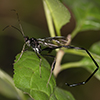



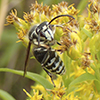




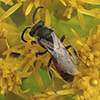



_02t.jpg)














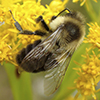
 \
\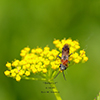












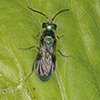












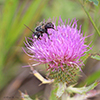









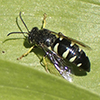

























_01t.jpg)









_02t.jpg)















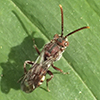



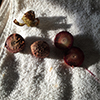






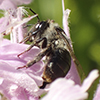









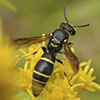




















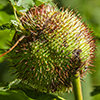










_01t.jpg)










